Principles of Plant Ecology | Botany - Answer the following questions (Pure Science Group) | 12th Botany : Chapter 6 : Principles of Plant Ecology
Chapter: 12th Botany : Chapter 6 : Principles of Plant Ecology
Answer the following questions (Pure Science Group)
Botany : Principles of Plant Ecology
Answer the following questions (Pure Science Group)
22. Define ecology.
Answer: (i) “The study of living organisms, both plants and animals, in their natural habitats or homes.” - Reiter (1885).
(ii) “Ecology is the study of the reciprocal relationship between living organisms and their environment.” - Earnest Haeckel (1889).
23. What is ecological hierarchy? Name the levels of ecological hierarchy.
Answer: The interaction of organisms with their environment results in the establishment of grouping of organisms which is called ecological hierarchy or ecological levels of organization. The basic unit of ecological hierarchy is an individual organism. The different hierarchy of ecological systems is illustrated below.
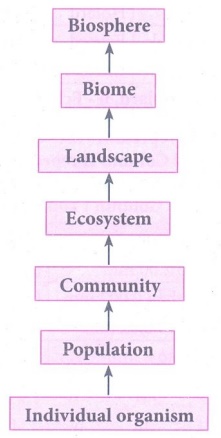
Biosphere
↑
Biome
↑
Landscape
↑
Ecosystem
↑
Community
↑
Population
↑
Individual organism
24. What are ecological equivalents? Give one example .
Answer: Taxonomically different species occupying similar habitats (Niches) in different geographical regions are called ecological equivalents.
Examples:
Certain species of epiphytic orchids of Western Ghats of India differ from the epiphytic orchids of South America. But they are epiphytes.
25. Distinguish habitat and niche
Answer:
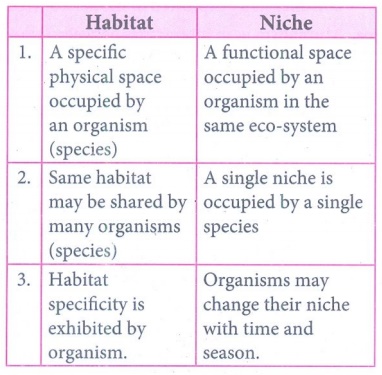
Habitat
1. A specific physical space occupied by an organism (species)
2. Same habitat may be shared by many organisms (species)
3. Habitat specificity is exhibited by organism.
Niche
1. A functional space occupied by an organism in the same eco-system
2. A single niche is occupied by a single species
3. Organisms may change their niche with time and season.
26. Why are some organisms called as eurythermals and some others as stenohaline ?
Answer: (i) Eurythermal Organisms: Organisms which can tolerate a wide range of temperature fluctuations.
Example : Zostera (A marine Angiosperm) and Artemisia tridentata.
(ii) Stenohaline Organisms : Organisms which can withstand only a small range of salinity.
Example : plants of estuaries.
27. ‘Green algae are not likely to be found in the deepest strata of the ocean’. Give at least one reason.
Answer: (i) Green algae not likely to be found in the deepest strata of the ocean because deep inside the sea presence of sufficient light for photosynthesis and brackish water are not available.
(ii) So green algae are not present at this level.
(iii) Instead algae inhabits littoral zone of water.
28. What is Phytoremediation ?
Answer: Phytoremediation is the use of plants to clean up environmental pollution.
Example:
Rice and Eichhornia (water hyacinth) tolerate cadmium by binding it to their proteins. These plants otherwise can also be used to remove cadmium from contaminated soil.
29. What is Albedo effect and write their effects?
Answer: (i) Emission of dust and aerosols (small solids or liquid particles in suspension in the atmosphere) from industries, automobiles, forest fire, SO2 and DMS (dimethyl sulphur) play an important role in disturbing the temperature level of any region.
(ii) Aerosols with small particles is reflecting the solar radiation entering the atmosphere.
(iii) This is known as Albedo effect. So it reduces the temperature (cooling) limits, photosynthesis and respiration.
30. The organic horizon is generally absent from agricultural soils because tilling, e.g., plowing, buries organic matter. Why is an organic horizon generally absent in desert soils ?
Answer: (i) O - Horizon (Organic horizon) Consists of fresh or partially decomposed organic matter.
(ii) O1 - Freshly fallen leaves, twigs, flowers and fruits O2 - Dead plants, animals and their excreta decomposed by micro-organisms.
(iii) Desert soil has very little water to support a large community of plants and animals.
(iv) Therefore the formation of O-Horizon is very negligible or absent in dessert soil.
31. Soil formation can be initiated by biological organisms. Explain how?
Answer: (i) Soil formation is initiated by the weathering process.
(ii) Biological weathering takes place when organisms like bacteria, fungi, lichens and plants help in the breakdown of rocks through the production of acids and certain chemical substances.
32. Sandy soil is not suitable for cultivation. Explain why?
Answer: Soils such as sand and clay are not suitable for growing crops. Sandy soil loses water at a high rate leading to a low level of water retention that is unsuitable for plant growth. Clay soil holds too much water leading to water logging.
33. Describe the mutual relationship between the fig and wasp and comment on the phenomenon that operates in this relationship.
Answer: (i) Mutualism exists between Fig tree and Wasp. The female Wasp uses the fruit not only for laying eggs but uses the developing seeds within the fruit for nourishing its larvae.
(ii) The Wasp pollinates all the flowers.
(iii) The flowers with eggs will not mature one other flowers mature.
(iv) The pollination in Fig (Ficus carica) by the Wasp is an example for plant - insect interaction.
34. Lichen is considered as a good example of obligate mutualism. Explain.
Answer: Mutualism : It is an interaction between two species of organisms in which both are benefited from the obligate association. The following are common examples of mutualism.
Obligate mutualism:
In obligate mutualism, one organism cannot survive without the other. Because both organisms are obligated, or forced to rely on one another.
Examples:
Lichen is a mutual association of an alga and a fungus.
Lichen is not a single organism, but the result of a partnership between a fungus and an alga or cyanobacteria. The body of a lichen consists of fungal filaments (hyphae) surrounding cells of green algae and blue-green cyanobacteria.
35. What is mutualism? Mention any two example where the organisms involved are commercially exploited in modern agriculture.
Answer: Mutualism is an interaction between two species of organisms in which both are benefitted from the obligate association. Common examples where the interaction is commercially exploited in modern agriculture are :
(i) The cyanobacterium Anabaena is found in the leaves of the water fern Azolla It is used as bio-fertilizer for wet land rice cultivation, since Anabaena fixes atmospheric nitrogen and lives in mutualistic association with Azolla. The soil is thus rich in nitrogen.
(ii) Mycorrihiza are formed by symbiotic association of certain fungal hyphae with roots of Angiosperms. They increase the availability of phosphorous in the soil and also assures water availability.
36. List any two adaptive features evolved in parasites enabling them to live successfully on their host?
Answer: (i) The parasitic plants produce the haustorical roots inside the host plant to absorb nutrients from the vascular tissues of host plants.
(ii) Cuscuta: The parasite gets flower inducing hormone from its host plant.
37. Mention any two significant roles of predation plays in nature.
Answer: (i) Many herbivores are predators. Cattles, Camels, Goats etc., frequently browse on the tender shoots of herbs, shrubs and trees. Generally annuals suffer more than the perennials. Grazing and browsing may cause remarkable changes in vegetation.
(ii) Many defense mechanisms are evolved to avoid their predations by plants.
Examples : Calotropis produces highly poisonous cardiacglycosides, Tobacco produces nicotine, coffee plants produce caffeine, Cinchona plant produces quinine. Thorns of Bougainvillea, spines of Opuntia, and latex of cacti also protect them from predators.
38. How does an orchid ophrys ensures its pollination by bees ?
Answer: Mimicry: It is a phenomenon in which living organism modifies its form, appearance, structure or behavior and looks like another living organism as a self defence and increases the chance of their survival. Floral mimicry is for usually inviting pollinators. Mimicry is a type of interspecific interaction.
Example:
The plant, Ophrys an orchid, the flower looks like a female bee to attract the male bee. The flower is pollinated by the male bee. It is otherwise called ‘floral mimicry’.
39. Water is very essential for life. Write any three features for plants which enable them to survive in water scarce environment.
Answer: The three features of plants which enable them to survive in water scarce environment are :
(i) The plants have leaves reduced, to spine to reduce the surface area and prevent loss of water by transpiration e.g. Opuntia
(ii) Plants have sunken stomata located in a small pit, which decreases water loss from the leaf. eg. Nerium
(iii) They have tissues, to store water in some cases, e.g. Opuntia
40. Why do submerged plants receive weak illumination than exposed floating plants in a lake?
Answer: Submerged plants receive weaker illumination than exposed floating plants in a lake because all colours of the visible components of the spectrum of light do not enter or penetrate in the depths of water.
41. What is vivipary? Name a plant group which exhibits vivipary.
Answer: (i) If seeds or embryos begin to develop before they detach from the parent. The Phenomenon is described as vivipary.
(ii) Seeds germinate in the fruits of mother plant itself. Halophytes exhibit vivipary. Example: Avicennia
42. What is thermal stratification? Mention their types.
Answer: Thermal Stratification:
It is usually found in aquatic habitat. The change in the temperature profile with increasing depth in a water body is called thermal stratification.
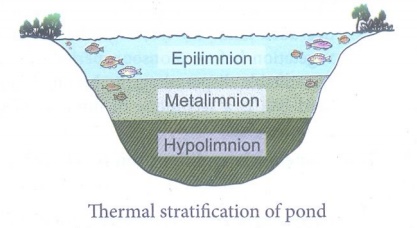
Thermal stratification of pond
3 kinds of thermal stratifications:
(i) Epilimnion - The upper layer of warmer water.
(ii) Metalimnion - The middle layer with a zone of gradual decrease in temperature.
(iii) Hypolimnion - The bottom layer of colder water.
43. How is rhytidome act as the structural defence by plants against fire?
Answer: (i) Rhytidome is the structural defense by plants against fire. The outer bark of trees which extends to the last formed periderm is called Rhytidome.
(ii) It is composed of multiple layers of suberized periderm, cortical and phloem tissues. It protects the stem against fire, water loss, invasion of insects and prevents infections by microorganisms.
44. What is myrmecophily?
Answer: (i) Myrmecophily : Sometimes, Ants take their shelter on some trees such as Mango, Litchi, Jamun, Acacia etc.
(ii) These ants act as body guards of the plants against any disturbing agent and the plants in turn provide food and shelter to these Ants. This phenomenon is known as Myrmecophily.
Example : Acacia and Acacia Ants.
45. What is seed ball?
Answer: (i) Seed ball is an ancient Japanese technique of encasing seeds in a mixture of clay and soil humus (also in Cow dung) and scattering them on to suitable ground, not planting of trees manually.
(ii) This method is suitable for barren and degraded lands for tree regeneration and vegetation before monsoon period where the suitable dispersal agents become rare. Seed ball is a technique of human aided seed dispersal.
46. How is anemochory differ from zoochory?
Answer:
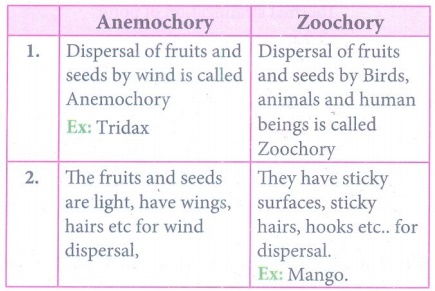
Anemochory
1. Dispersal of fruits and seeds by wind is called Anemochory
Ex: Tridax
2. The fruits and seeds are light, have wings, hairs etc for wind dispersal,
Zoochory
1. Dispersal of fruits and seeds by Birds, animals and human beings is called Zoochory
2. They have sticky surfaces, sticky hairs, hooks etc., for dispersal.
Ex: Mango.
47. What is co evolution?
Answer: The interaction between organisms, when continues for generations, involves reciprocal changes in genetic and morphological characters of both organisms. This type of evolution is called co-evolution. It is a kind of co-adaptation and mutual change among interactive species.
Examples :
(i) Corolla length and proboscis length of butterflies and moths (Habenaria and Moth).
(ii) Bird’s beak shape and flower shape and size.
More examples: Horn bills and birds of Scrub jungles, Slit size of pollinia of Apocynaceae members and leg size of insects.
It is an inter specific interaction.
48. Explain Raunkiaer classification in the world’s vegetation based on the temperature.
Answer: Raunkiaer classified the world’s vegetation into the following 4 types based on the temperature prevailing in an area.
(i) Megatherms
(ii) Mesotherms
(iii) Microtherms
(iv) Hekistotherms.
In thermal springs and deep sea hydrothermal vents where average temperature exceed 100°c. Based on the range of thermal tolerance, organisms are divided into two types.
(a) Eurythermal : Organisms which can tolerate a wide range of temperature fluctuations.
Example : Zostera (A marine Angiosperm) and Artemisia tridentata.
(b) Stenothermal : Organisms which can tolerate only small range of temperature variations.
Example : Mango and Palm (Terrestrial Angiosperms).
Mango plant do not and cannot grow in temperate countries like Canada and Germany.
Thermal Stratification:
It is usually found in aquatic habitat. The change in the temperature profile with increasing depth in a water body is called thermal stratification.
3 kinds of thermal stratifications:
(i) Epilimnion - The upper layer of warmer water.
(ii) Metalimnion - The middle layer with a zone of gradual decrease in temperature.
(iii) Hypolimnion - The bottom layer of colder water.
Temperature based zonation:
Variations in latitude and altitude do affect the temperature and the vegetation on the earth surface. The latitudinal and altitudinal zonation of vegetation is illustrated below:
Latitude : Latitude is an angle which ranges from 0° at the equator to 90° at the poles.
Altitude : How high a place is located above the sea level is called the altitude of the place.
Timber line / Tree line : It is an imaginary line in a mountain or higher areas of land that marks the level above which trees do not grow. The altitudinal limit of normal tree growth is about 3000 to 4000m.
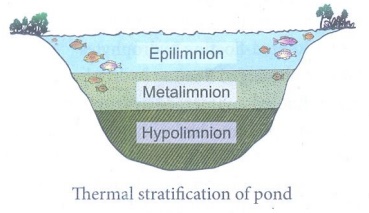
49. List out the effects of fire to plants.
Answer: (i) Fire has a direct lethal effect on plants.
(ii) Burning scars are the suitable places for the entry of parasitic fungi and insects.
(iii) It brings out the alteration of light, rainfall, nutrient cycle, fertility of soil, pH, soil flora and fauna.
(iv) Some fungi which grow in soil of burnt areas are called pyrophilous.
Example: Pyronema confluens.
50. What is soil profile? Explain the characters of different soil horizons.
Answer: Soil is commonly stratified into horizons at different depth. These layers differ in their physical, chemical and biological properties. This succession of super-imposed horizons is called soil profile.
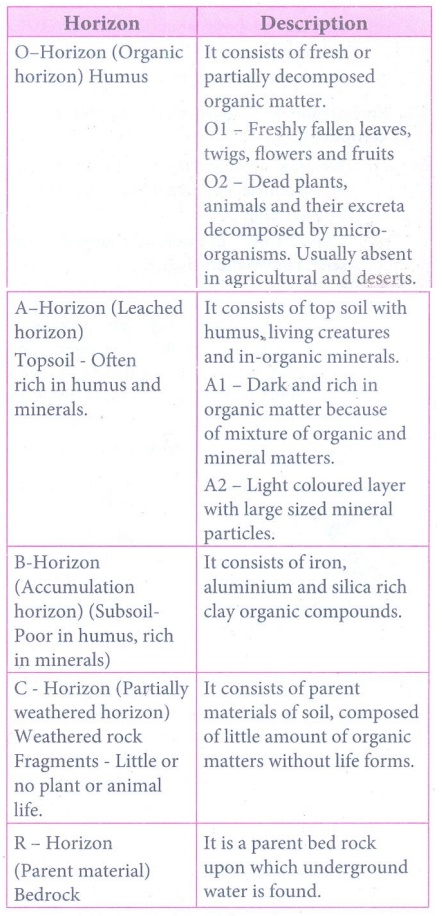
Horizon
• O - Horizon (Organic horizon) Humus
• A- Horizon (Leached horizon) Topsoil – Often rich in humus and minerals.
• B- Horizon ( Accumulation horizon ) ( Subsoil –Poor in humus, rich in minerals )
• C- Horizan ( Partially weathered horizon ) Weathered rock Fragments – Little or no plant or animal life.
• R – Horizon (Parent material) Bedrock
Description
• It consists of fresh or partially decomposed organic matter.
O1 - Freshly fallen leaves, twigs, flowers and fruits
O2 - Dead plants, animals and their excreta decomposed by micro¬organisms. Usually absent in agricultural and deserts.
• It consists of top soil with humans living creatures and in - organic minerals.
A1 – Dark and rich in organic matter because of mixture of organic and mineral matters.
A2 – Light coloured layer with large sized mineral particles.
• It consists of iron, aluminium and silica rich clay organic compounds.
• It consists of parent materials of soil, composed of little amount of organic matters without life forms.
• It is a parent bed rock upon which underground water is found.
51. Give an account of various types of parasitism with examples.
Answer: Parasitism : It is an interaction between two different species in which the smaller partner (parasite) obtains food from the larger partner (host or plant). So the parasitic species is benefited while the host species is harmed. Based on the host- parasite relationship.
Parasitism is of 2 types:
(i) Holoparasite (ii) Hemiparasite.
(i) Holoparasites:
The organisms which are dependent upon the host plants for their entire nutrition are called Holoparasites. They are also called total parasites.
Examples :
(a) Cuscuta is a total stem parasite of the host plant Acacia, Duranta and many other plants. Cuscuta even gets flower inducing hormone from its host plant.
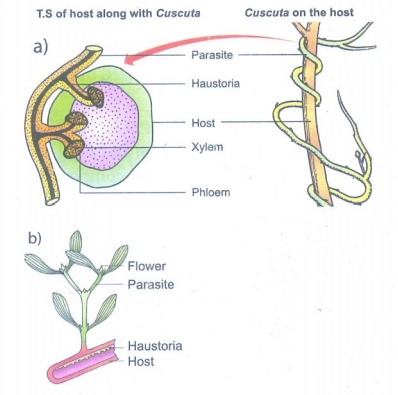
a) Holoparasite - Cuscuta
b) A Partial stem parasite - Viscum
c) Root parasite on the brinjal root - Orabanche spp.
(b) Balanophora, Orabanche and Rafflesia are the total root parasites found on higher plants.
(ii) Hemiparasites:
The organisms which derive only water and minerals from their host plant while synthesizing their own food by photosynthesis are called Hemiparasites. They are also called partial parasites.
Examples:
(a) Viscum and Loranthus are partial stemparasites.
(b) Santalum (Sandal Wood) is a partial rootparasite.
The parasitic plants produce the haustorial roots inside the host plant to absorb nutrients from the vascular tissues of host plants.
52. Explain different types of hydrophytes with examples.
Answer: Hydrophytes are classified according to their relation to water and air. They are sub-divided into following categories:
(i) Free floating hydrophytes
(ii) Rooted-floating hydrophytes
(iii) Submerged floating hydrophytes
(iv) Rooted-submerged hydrophytes
(v) Amphibious hydrophytes.
(i) Free floating hydrophytes : These plants float freely on the surface of water. They remain in contact with water and air, but not with soil.
Examples : Eichhornia, Pistia and Wolffia
(ii) Rooted floating hydrophytes : The roots are fixed in mud, but their leaves and flowers are floating on the surface of water. Plants are in contact with soil, water and air.
Examples: Nelumbo, Nymphaea,
(iii) Submerged floating hydrophytes : Plants are completely submerged in water and not in contact with soil and air.
Examples : Ceratophyllum and Utricularia.
(iv) Rooted-submerged hydrophytes : Plants are completely submerged in water and rooted in soil and not in contact with air.
Examples: Hydrilla, Vallisneria and Isoetes.
(v) Amphibious hydrophytes (Rooted emergent hydrophytes) : Plants are adapted to both aquatic and terrestrial modes of life. Grow in shallow water. Examples: Ranunculus, Typha
53. Enumerate the anatomical adaptations of xerophytes.
Answer: (i) Presence of multi layered epidermis with heavy cuticle to prevent water loss due to transpiration.
(ii) Hypodermis is well developed with sclerenchymatous tissues.
(iii) Sunken shaped stomata are present only in the lower epidermis with hairs in the sunken pits.
(iv) Scotoactive type of stomata found in succulent plants.
(v) Vascular bundles are well developed with several layered bundle sheath.
(vi) Mesophyll is well differentiated into palisade and spongy parenchyma.
(vii) In succulents the stem possesses a water storage region.
54. List out any five morphological adaptations of halophytes.
Answer: (i) The temperate halophytes are herbaceous but the tropical halophytes are mostly bushy.
(ii) In addition to the normal roots, many stilt roots are developed.
(iii) A special type of negatively geotropic roots called pneumatophores with pneumathodes to get sufficient aeration are also present. They are called breathing roots. Example : Avicennia
(iv) Presence of thick cuticle on the aerial parts of the plant body.
(v) Leaves are thick, entire, succulent and glossy. Some species are aphyllous (without leaves).
(vi) Vivipary mode of seed germination is found in halophytes.
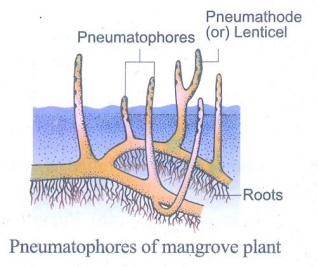
55. What are the advantages of seed dispersal?
Answer: Advantages of seed dispersal:
(i) Seeds escape from mortality near the parent plants due to predation by animals or getting diseases and also avoiding competition.
(ii) Dispersal also gives a chance to occupy favourable sites for growth.
(iii) It is an important process in the movement of plant genes. Particularly this is the only method available for self-fertilized flowers and maternally transmitted genes in out crossing plants.
(iv) Seed dispersal by animals help in conservation of many species even in human altered ecosystems.
(v) Understanding of fruits and seed dispersal acts as a key for proper functioning and establishment of many ecosystems from deserts to evergreen forests and also for the maintenance of biodiversity conservation and restoration of ecosystems.
56. Describe dispersal of fruit and seeds by animals.
Answer: Birds and mammals, including human beings play an efficient and important role in the dispersal of fruit and seeds. They have the following devices.
(i) Hooked fruit : The surface of the fruit or seeds have hooks, (Xanthium), barbs (Andropogon), spines (Aristida) by means of which they adhere to the body of animals or clothes of human beings and get dispersed.
(ii) Sticky fruits and seeds :
(a) Some fruits have sticky glandular hairs by which they adhere to the fur of grazing animals.
Example : Boerhaavia and Cleome.
(b) Some fruits have viscid layer which adhere to the beak of the bird which eat them and when they rub them on to the branch of the tree, they disperse and germinate.
Example : Cordia and Alangium
(iii) Fleshy fruits : Some fleshy fruits with conspicuous colours are dispersed by human beings to distant places after consumption.
Example : Mango and Diplocyclos
Related Topics